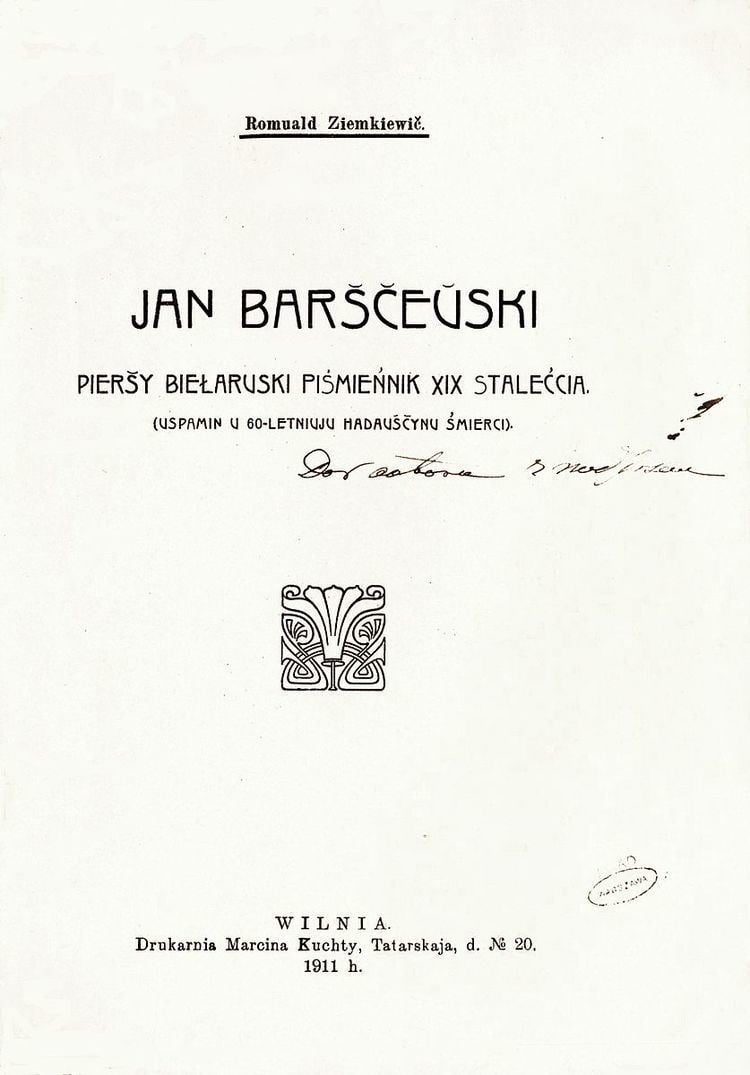 | ||
The Belarusian Latin alphabet or Łacinka ([laˈt͡sinka], from Belarusian: лацінка (BGN/PCGN: latsinka) for the Latin script in general) is the common name of the several historical alphabets to render the Belarusian (Cyrillic) text in Latin script. It is similar to the Sorbian alphabet, incorporating features of the Polish and Czech alphabets.
Contents
Use
Łacinka was occasionally used in the Belarusian area mainly in the 19th century and first years of the 20th century. Belarusian was officially written only in the Latin script between 1941 and 1944, in the Nazi German-occupied Belarusian territories.
It is used occasionally in its current form by certain authors, groups and promoters in the Nasha Niva weekly, the ARCHE journal, and some of the Belarusian diaspora press on the Internet.
It is not, as such, the Romanisation system, as it imposes knowing certain accompanying orthographic conventions. For instance, the Łacinka equivalent to Cyrillic е is either e, ie or je, depending on the pronunciation and on the preceding sound. Also, there is no soft sign in Łacinka, palatalisation instead being represented by a diacritic on the preceding consonant.
The official Belarusian Romanisation 2007 system is similar to Łacinka, but differs in transliterating the Cyrillic л: л = ł (Łacinka) = l (official), ль = l (Łacinka) = ĺ (official), ля = la (Łacinka) = lia (official).
History
In Medieval times (16th century), the first examples of the Latin renderings of the Belarusian (Cyrillic) text are known to occur, coming from the need to include the Old Belarusian quotes in the Polish and Latin texts. Those renderings were un-codified and, seemingly, were done by applying the Polish orthography to the Old Belarusian sounds.
In the 17th century, Belarusian Roman Catholics gradually increased their use of the Latin script, but still largely in parallel with the Cyrillic. Before the 17th century the Belarusian Roman Catholics had been using the Cyrillic script widely.
In the 18th century, the Latin script was used, in parallel with Cyrillic, in some literary works (e.g., dramatic), written in contemporary Belarusian.
In the 19th century, some Polish and Belarusian writers of Polish cultural background used the Latin script, exclusively or occasionally, in their works written in Belarusian, notably Jan Czeczot, Paŭluk Bahrym, Vincent Dunin-Marcinkievič, Francišak Bahuševič, and Adam Hurynovič. The Revolutionary Democrat Kalinowski used the Latin script exclusively in his newspaper Peasants’ Truth (Belarusian: Мужыцкая праўда, in Latin script: Mużyckaja prauda; six issues in 1862–1863).
Such introduction of the Latin script for the rendering of the language with far-reaching Cyrillic tradition is sometimes explained by the unfamiliarity of the 19th century writers with the history of the Belarusian language or with the language itself, or by the impossibility of either acquiring or deploying the Cyrillic type at the publishing sites those writers had been using.
The custom of using the Latin script for Belarusian text gradually ceased in the common practice, although at the beginning of the 20th century there were still several examples of exclusive or non-exclusive use of the Latin script in Belarusian printing:
In the 1920s in the Belarusian SSR, e.g., at the Belarusian Academic Conference (1926), some suggestions were made to consider transition of the Belarusian grammar to the Latin script (e.g., Zmicier Zhylunovich, for the sake of "making the Belarusian grammar more progressive"). However, these suggestions were rejected by the Belarusian linguists (e.g., Vaclau Lastouski).
In the 1920s–1939, after the partition of Belarus (1921), use of the Latin script, in evolved form, was re-introduced to Belarusian printing in Western Belarus, chiefly for political reasons. The proposed form of the Belarusian Latin alphabet and some grammar rules were introduced for the first time in the 5th (unofficial) edition of the Tarashkyevich’s grammar (Vil’nya, 1929).
Belarusian was written in the Latin script during 1941–1944 in the German-occupied Belarusian territories, and by the Belarusian diaspora in Prague (1920s – c.1945).
After the Second World War, Belarusian was occasionally written in the Latin script by the Belarusian diaspora in non-Soviet Europe and the Americas (notably in West Germany and the USA). In 1962, Yan Stankyevich proposed a completely different form of the Belarusian Latin alphabet.
